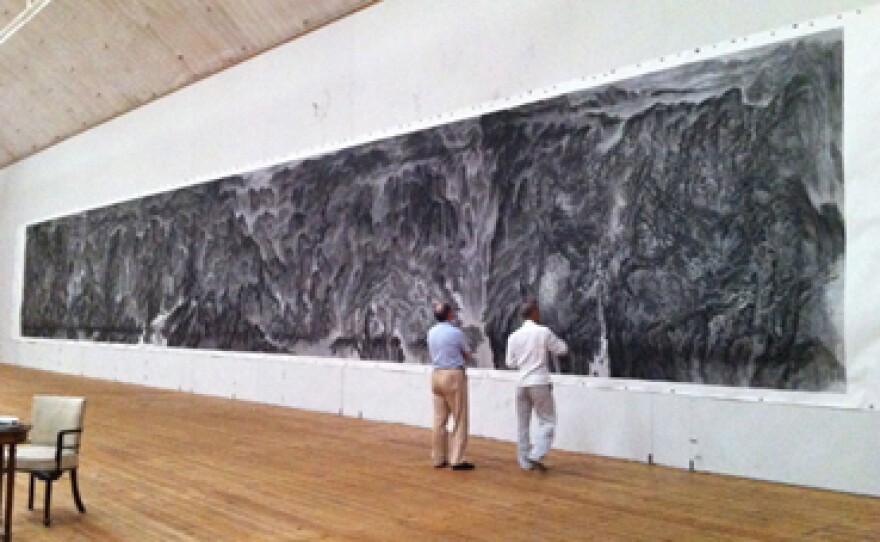Nature has provided a source of inspiration for Chinese poets and painters for thousands of years. An exhibition at the Nelson-Atkins Museum of Art juxtaposes the old with the new - showcasing some of the museum’s collection of Song Dynasty paintings, as well as a monumental landscape by a contemporary Chinese artist.
Landscape paintings traditions, old and new
Colin Mackenzie is the senior curator of Chinese art at the Nelson-Atkins. He stands in Kirkwood Hall, at the heart of the original building. It’s a vast room, with 40-foot-tall ceilings, flanked by black marble columns. But, the center of the room is now occupied by a massive scroll, a dense landscape painted 2002 - 2008 by artist Xu Longsen.
"What he has done is he’s made landscape almost cosmic in scale," says Mackenzie.
Nearby, a case was built to hold a more intimate work. This hand scroll, Illustration to the Second Prose Poem on the Red Cliff, attributed to Qiao Zhongchang, dates to about 1100. Mackenzie says it illustrates one of the most famous poems in Chinese culture.
"It describes a journey, a picnic, if you like, that the poet took to the site of an ancient battle of the Red Cliff," says Mackenzie. "But it’s not about the battle, it’s about his psychological experience, going back to visit the site of the battle for the second time and how he interacts with nature.
"Nature really is at the hub of landscape painting in China. Landscape painting in China is not just pretty scenery. It carries a moral message."
These two works are part of an exhibition called Journey through Mountains and Rivers: Chinese Landscapes Ancient and Modern. It traces the rise of the landscape tradition from the 10th to the 13th centuries –and how it continues to flourish in the present day.
"Wise men love waters, virtuous men love mountains"
"Confucius actually said that the wise men love waters, and the virtuous men love mountains," says Mackenzie. "And the Chinese word for landscape actually is mountains and waters, those same characters. You improve yourself through interaction, through communion with nature."
In Chinese landscape – human figures are often very small, reflecting the Taoist philosophy that humans are tiny specks in a vast cosmos. And artist’s Xu Longsen's painting in Kirkwood Hall is called The Law of the Dao is its Being What it Is.
"The painting that we’re looking at here is 86 feet long by 12 feet tall," says Mackenzie. "It’s probably the largest Chinese landscape painting ever painted. It’s possibly the largest painting ever painted. So it's just huge, monumental, gigantic in scale."
According to Mackenzie, Xu's studio is like an aircraft hangar – the artist was able to paint it in one straight line. But the museum doesn’t have a gallery 90 feet long, so the work is hung in a semi-circle. Mackenzie says you can get fairly close, but it’s best viewed from about 10 feet away.
"It’s a much more public work," says Mackenzie. "Another unintended, but beneficial effect of hanging it in a semi-circle is that you’re almost enclosed by it. You’re immersed in it, so you feel as if you’re almost walking into a landscape."
Paintings to look into, travel through, and dwell
A walk from one gallery to the next is part of the experience of the exhibition – it stretches into four galleries at the Nelson, including Kirkwood Hall. On the second floor, artist Xu Longsen is in residence for a week painting in an artist’s studio; there’s also the Chinese Furniture gallery with some of Xu’s smaller paintings, and the Chinese painting gallery.
"We’ve now entered the holy of holies which is where we’re displaying our eight Sung Dynasty masterpiece," says Mackenzie who's limited the number of works in this gallery, so visitors can focus on the details and take a journey through the paintings.
"They’re long, horizontal hand scrolls. You start at the right and you come across figures walking through the landscape, people in boats, little temples, fishermen," says Mackenzie. "There’s one painting called Fishermen's Evening Song where fishermen are actually toasting another fisherman who’s made a catch, so tiny, that’s it’s very easy to overlook them.
"They give scale to the monumental grandeur of the scenery behind. The fishermen scroll is a scroll that moves me every time I open it, it's just such an astonishing work."
Mackenzie says, according to the ancient critics, there are some paintings you can look into, some you travel through, and others in which you can dwell. He says it’s the ones you can travel through - and can dwell – that are the finest.
Journey through Mountains and Rivers: Chinese Landscapes Ancient and Modern through April 28, 2013 at the Nelson-Atkins Museum of Art, 4525 Oak Street, Kansas City, Mo. 816-751-1ART. Artist Xu Longsen is in residence at the museum for one week, February 8 - 15, in the Scholar's Studio. For hours, check the museum website.






